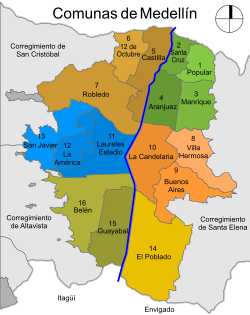Communes of Medellín
- Machine translation, like DeepL or Google Translate, is a useful starting point for translations, but translators must revise errors as necessary and confirm that the translation is accurate, rather than simply copy-pasting machine-translated text into the English Wikipedia.
- Consider adding a topic to this template: there are already 942 articles in the main category, and specifying
|topic=will aid in categorization. - Do not translate text that appears unreliable or low-quality. If possible, verify the text with references provided in the foreign-language article.
- You must provide copyright attribution in the edit summary accompanying your translation by providing an interlanguage link to the source of your translation. A model attribution edit summary is
Content in this edit is translated from the existing Spanish Wikipedia article at [[:es:Comunas de Medellín]]; see its history for attribution. - You may also add the template
{{Translated|es|Comunas de Medellín}}to the talk page. - For more guidance, see Wikipedia:Translation.
Communes of Medellín Comunas de Medellín | |
|---|---|
 | |
| Website | www |
The urban area of Medellín, Colombia is divided into six zones, which in turn are divided into 16 communes.[1] Communes are then divided into neighborhoods (Spanish: barrios) and institutional areas. The city has 249 neighborhoods and 20 institutional areas. Institutional areas are large sectors with some neighborhood characteristics, but its populations are not permanent and lack housing. An example of an institutional area is a university campus.
The rural areas of Medellín are divided into 5 corregimientos, these in turn are divided into villages. The districts San Antonio de Prado and San Cristóbal are the most populous districts Colombia, with over thirty thousand inhabitants each. Medellín is structured following the flow of the Medellín River, which runs from south to north.
The six zones and 16 communes are the following:
- Zone 1 - Northeast
- Commune 1 - Popular
- Commune 2 - Santa Cruz
- Commune 3 - Manrique
- Commune 4 - Aranjuez
- Zone 2 - Northwest
- Commune 5 - Castilla
- Commune 6 - Doce de octubre
- Commune 7 - Robledo
- Zone 3 - Center east
- Commune 8 - Villa Hermosa
- Commune 9 - Buenos Aires
- Commune 10 - La Candelaria
- Zone 4 - Center west
- Commune 11 - Laureles—Estadio
- Commune 12 - La América
- Commune 13 - San Javier
- Zone 5 - Suroriental
- Commune 14 - El Poblado
- Zone 6 - Suroccidental
- Commune 15 - Guayabal
- Commune 16 - Belén
References
- ^ Esteban Fernández Vázquez; Fernando Rubiera Morollón (11 January 2013). Defining the Spatial Scale in Modern Regional Analysis: New Challenges from Data at Local Level. Springer Science & Business Media. p. 240. ISBN 978-3-642-31994-5.












